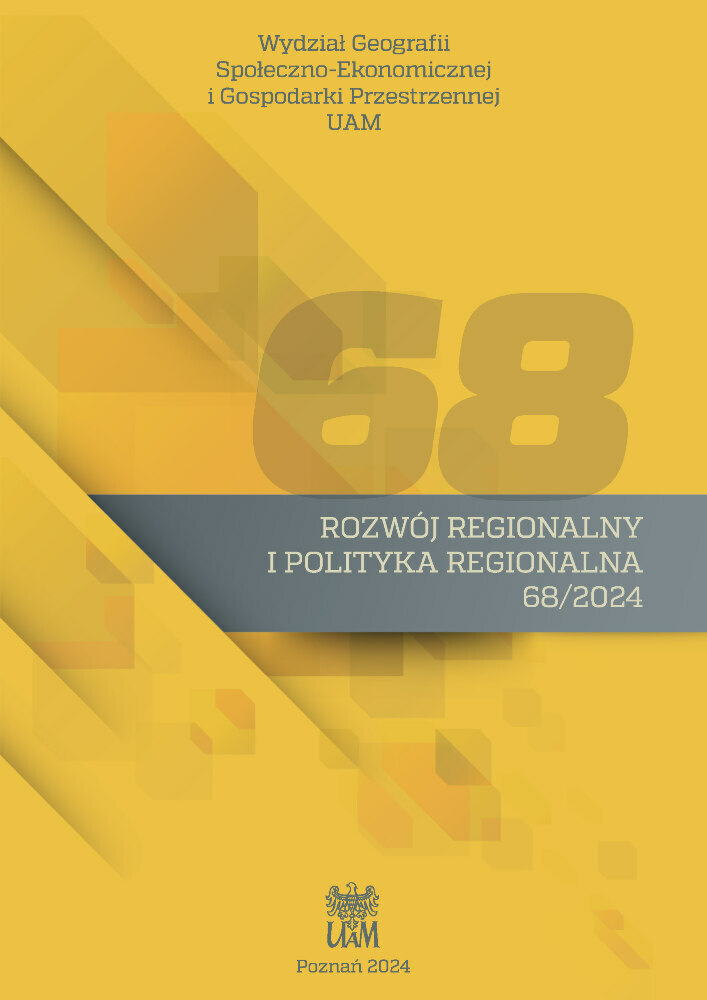Abstrakt
Population dynamics shape the spatial landscape of Europe. Although broadly studied, both suburban sprawl and inner-city reurbanisation have often been treated in isolation. Furthermore, these processes manifest distinctively across different local contexts. This research aimed to explore the population dynamics in the inner city of Riga from 2011 to 2021, contrasting them with the bordering municipalities of Riga, and to analyze how these dynamics align with the urban development model. Covering 58 neighborhoods and 7 bordering municipalities of Riga, the analysis revealed a shift in the trajectory of inner-city population dynamics during the latter half of the decade, which was finally characterized by growth. However, suburbanisation continued to outpace reurbanisation, indicating the coexistence of multiple urban development model stages.
Finansowanie
This research is funded by the project “Strengthening of the capacity of doctoral studies at the University of Latvia within the framework of the new doctoral model”, identification No. 8.2.2.0/20/I/006
Bibliografia
Balode S. 2023. Shifting inner-city sociodemographics: the case of Riga. Folia Geographica, 20(2): 64-73. DOI: https://doi.org/10.22364/fg.20.2.7
Booi H., Boterman W., Musterd S. 2020. Staying in the city or moving to the suburbs? Unravelling the moving behaviour of young families in the four big cities in the Netherlands. Population, Space and Place, 27(3). DOI: https://doi.org/10.1002/psp.2398
Buzar S., Ogden P., Hall R., Haase A., Kabisch S., Steinfiihrer A. 2007. Splintering Urban Populations: Emergent Landscapes of Reurbanisation in Four European Cities. Urban Studies, 44(4): 651-677. DOI: https://doi.org/10.1080/00420980601185544
Central Statistical Bureau of Latvia (CSB). 2023 (https://data.stat.gov.lv/pxweb/lv/OSP_PUB/START__POP__IR/).
Dembski S., Sykes O., Couch C., Desjardins X., Evers D., Osterhage F., Siedentop S., Zimmermann K. 2021. Reurbanisation and suburbia in Northwest Europe: A comparative perspective on spatial trends and policy approaches. Progress in Planning, 150: 100462. DOI: https://doi.org/10.1016/j.progress.2019.100462
Fabula S., Boros L., Kovács Z., Horváth D., Pál V. 2017. Studentification, diversity and social cohesion in post-socialist Budapest. Hungarian Geographical Bulletin, 66(2): 157-173. DOI: https://doi.org/10.15201/hungeobull.66.2.5
Grabkowska M. 2011. Inner-city transformations after socialism findings from interviews with new residents of pre-war tenement houses in Gdańsk. Bulletin of Geography. Socio-economic Series, 15(15): 117-129. DOI: https://doi.org/10.2478/v10089-011-0008-7
Haase A., Kabisch S., Steinführer A., Bouzarovski S., Hall R., Ogden P. 2010. Emergent spaces of reurbanisation: Exploring the demographic dimension of inner-city residential change in a European setting. Population, Space and Place, 16(5): 443-463. DOI: https://doi.org/10.1002/psp.603
Haase A., Wolff M., Špačková P., Radzimski A. 2018. Reurbanisation in Postsocialist Europe – A Comparative View of Eastern Germany, Poland, and the Czech Republic. Comparative Population Studies, 42. DOI: https://doi.org/10.12765/CPoS-2018-02
Haase D., Haase A., Kabisch S., Bischoff P. 2008. Guidelines for the ‘Perfect inner city’. Discussing the appropriateness of monitoring approaches for reurbanisation. European Planning Studies, 16(8): 1075-1100. DOI: https://doi.org/10.1080/09654310802315765
Hesse M., Siedentop S. 2018. Suburbanisation and suburbanisms – making sense of continental European developments. Raumforschung und Raumordnung/Spatial Research and Planning, 76(2). DOI: https://doi.org/10.1007/s13147-018-0526-3
Horňáková M., Sýkora J. 2021. From suburbanisation to reurbanisation? Changing residential mobility flows of families with young children in the Prague metropolitan area. Norsk Geografisk Tidsskrift – Norwegian Journal of Geography, 75(4): 203-220. DOI: https://doi.org/10.1080/00291951.2021.1970014
Kabisch N., Haase D. 2009. Diversifying European agglomerations: Evidence of urban population trends for the 21st Century. Population, Space and Place, 17(3): 236-253. DOI: https://doi.org/10.1002/psp.600
Krišjāne Z., Bērziņš M. 2014. Intra-urban residential differentiation in the post-Soviet city: The case of Riga, Latvia. Hungarian Geographical Bulletin, 63(3): 235-253. DOI: https://doi.org/10.15201/hungeobull.63.3.1
Kubeš J., Kovács Z. 2020. The kaleidoscope of gentrification in post-socialist cities. Urban Studies, 57(13): 2591-2611. DOI: https://doi.org/10.1177/0042098019889257
Marcińczak S., Tammaru T., Ogrodowczyk A. 2017. Exploring patterns of socioeconomic residential intermixing in Tallinn. Cities, 67: 95-103. DOI: https://doi.org/10.1016/j.cities.2017.04.011
Salvati L., Serra P., Bencardino M., Carlucci M. 2019. Re-urbanizing the European City: A Multivariate Analysis of Population Dynamics During Expansion and Recession Times. Eur. J. Population, 35: 1-28. DOI: https://doi.org/10.1007/s10680-017-9462-0
Sýkora L. 2009. Post-Socialist Cities.[W:] International Encyclopedia of Human Geography. Elsevier, s. 387-395. DOI: https://doi.org/10.1016/B978-008044910-4.01072-5
Temelová J., Novák J., Kährik A., Tammaru T. 2016. Neighbourhood Trajectories in the Inner Cities of Prague and Tallinn: What Affects the Speed of Social and Demographic Change? Geografiska Annaler: Series B, Human Geography, 98, 4: 349-366. DOI: https://doi.org/10.1111/geob.12109
Treija S., Bratuškins U., Barvika S., Bondars E. 2020. The Liveability of Historical Cities: Current State and Prospects for Habitation. WIT Transactions on The Built Environment. DOI: https://doi.org/10.2495/GD170021
Valatka V., Burneika D., Ubarevičienė R. 2015. Large social inequalities and low levels of socio-economic segregation in Vilnius. Socio-Economic Segregation in European Capital Cities: East Meets West, 313-332.
van den Berg L., Drewett R., Klaassen L. 1982. Urban Europe: A Study of Growth and Decline. Vol. 1. Pergamon Press.
Zukin S. 1987. Gentrification: Culture and capital in the urban core. Annual Review of Sociology, 13(1): 129-147. DOI: https://doi.org/10.1146/annurev.soc.13.1.129
Licencja
Prawa autorskie (c) 2024 Sindija Balode, Zaiga Krišjāne

Utwór dostępny jest na licencji Creative Commons Uznanie autorstwa 4.0 Międzynarodowe.

